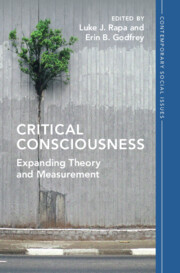Book contents
- Critical Consciousness
- Contemporary Social Issues
- Critical Consciousness
- Copyright page
- Dedication
- Contents
- Figures
- Tables
- Contributors
- Acknowledgments
- Introduction Critical Consciousness Theory and Measurement
- Part I Theory
- Part II Measurement
- 7 Critical Consciousness Measurement
- 8 Using Social Network Analysis to Identify Individual and Structural Precursors for Promoting Critical Consciousness in Childhood and Adolescence
- 9 Conceptualizing Adolescents’ Daily Critical Consciousness
- 10 Measurement and Analysis in Quantitative Critical Consciousness Research
- 11 The Development of the Contemporary Critical Consciousness Measure-Short
- Conclusion Expanding Critical Consciousness Theory and Measurement
- Index
- References
8 - Using Social Network Analysis to Identify Individual and Structural Precursors for Promoting Critical Consciousness in Childhood and Adolescence
from Part II - Measurement
Published online by Cambridge University Press: 20 April 2023
- Critical Consciousness
- Contemporary Social Issues
- Critical Consciousness
- Copyright page
- Dedication
- Contents
- Figures
- Tables
- Contributors
- Acknowledgments
- Introduction Critical Consciousness Theory and Measurement
- Part I Theory
- Part II Measurement
- 7 Critical Consciousness Measurement
- 8 Using Social Network Analysis to Identify Individual and Structural Precursors for Promoting Critical Consciousness in Childhood and Adolescence
- 9 Conceptualizing Adolescents’ Daily Critical Consciousness
- 10 Measurement and Analysis in Quantitative Critical Consciousness Research
- 11 The Development of the Contemporary Critical Consciousness Measure-Short
- Conclusion Expanding Critical Consciousness Theory and Measurement
- Index
- References
Summary
Developmental scientists stress the importance of exploring relational processes and contexts in association with critical consciousness (CC) development. Such inquiries are critical as the social relationships within a setting can impact a young person’s ability to exercise power and have direct implications for access to valued resources. Social network analysis (SNA) offers a developmentally inclusive lens for understanding the interactions between individual behaviors and setting-level contexts by identifying patterns of relationships among sets of actors within a system. In this chapter, we describe how SNA can help us operationalize children’s and adolescents’ understanding of power dynamics within everyday proximal settings. Specifically, we highlight the potential of SNA to quantify early developmental understandings and savviness in assessing multiple components of CC. In other words, measures of SNA at the individual, dyadic, and setting-level act as precursors that can be used to engage in CC before a fuller analysis of larger social conditions emerges developmentally.
Keywords
- Type
- Chapter
- Information
- Critical ConsciousnessExpanding Theory and Measurement, pp. 202 - 227Publisher: Cambridge University PressPrint publication year: 2023
References
- 2
- Cited by

